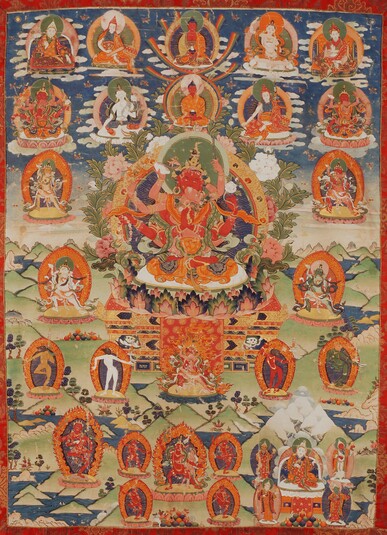
Item: Avalokiteshvara (Bodhisattva & Buddhist Deity) - Jinasagara (Ocean of Conquerors, Four Arms)
| Origin Location | Tibet |
|---|---|
| Date Range | 1800 - 1899 |
| Lineages | Nyingma and Buddhist |
| Material | Ground Mineral Pigment on Cotton |
| Collection | Rubin Museum of Art |
Alternate Names: Lokeshvara Avalokita Lokanata Lokanatha Mahakarunika
Classification: Deity
Appearance: Peaceful
Gender: Male
Red Avalokiteshvara, Ocean of Conquerors (Tibetan: chen re zi gyal wa gya tso. Sanskrit: Jinasagara Avalokiteshvara): from the Minling De Kun cycle of teachings belonging to the 'Revealed Treasures' of the Mindroling Monastery of the Nyingma School of Tibetan Buddhism (see Initiation Card Set).
This meditational practice in its earliest form is said to have come down through the Indian lineage of the female Tantric practitioner Siddharajnyi (Drupa'i Gyalmo) - pictured at the top right side - white in colour, holding a damaru drum upraised in the right hand and a skullcup in the left. (See another painting of Jinasagara with an image of Siddharajnyi).
The lineage of the Five Deity Jinasagara, an earlier form of the practice popular in the Karma Kagyu Tradition, dates to the time of the 2nd Karmapa Karma Pakshi and lists the teachers as: Dharmakaya Amitabha, Sambhogakaya Avalokiteshvara, Nirmanakaya Padmasambhava, Machig Drupa'i Gyalmo (Siddhirajni), Tebu Drime Shenyen, Rechung Dorje Drag, Lama Zangri Repa, Drogon Repa Chenpo, Gyalse Punya Vajra, Drupchen Karma Pakshi - the 2nd Karmapa, etc.
The central figure of Jinasagara is peaceful in appearance with eyes semi-closed, he holds a blue wish-fulfilling jewel in the clasped hands at the heart. Held in the second pair is a jewel mala of beads in the right and a red jewel lotus in the left. Adorned with a gold crown, earrings, necklaces and bracelets, he wears a krishnasara deerskin over the left shoulder, a green scarf and lower garments of orange and blue. With the legs crossed, right over left, in vajra posture he sits atop a white moon disc and multi-coloured lotus blossom surrounded by radiant spheres of light.
Accompanying the central figure are four Heruka couples. Below those are four Gate-keeper Deities, female, each with an animal head. Directly below the throne of the central Jinasagara is wrathful Hayagriva, red in colour, with one face and two arms, standing, surrounded by a mass of orange and red flames.
Directly above the central figure are two Amitabha Buddha depictions. At the viewer's left side are two Indian teachers and on the right side are Siddharajnyi and a Tibetan teacher likely of the Terdag Lingpa family wearing the lotus hat and the lower garment in the traditional white colour signifying a lay Tantric adept in the hereditary family line. The lower Amitabha is flanked by Avalokiteshvara on the and Padmasambhava on the right. At the far right and left are variant forms of Jinasagara Avalokiteshvara.
In the lower portion of the composition are a number of special deities that belong to the cycle of practices of the Jinasagara Avalokiteshvara. They are special because they are more directed and specific as to the function they perform - primarily power and wealth. The first, at the center is Lha Chenpo and retinue. On the right is the solitary Guhya Jnana and on the right side is Tseringma and retinue.
Lha Chenpo is a 'Revealed Treasure' deity form of Avalokiteshvara, an emanation, appearing as Mahadeva (Shiva) with consort and four standing retinue figures. "...Great God, Ishvara, with a body red in colour, like ruby, blazing with light. Having one face, two hands and three eyes, charming and passionate in appearance. In the right [hand] holding aloft a hook to gather the Three Realms and the left a lasso of wind. The hair is bound in a tuft decorated with a crescent moon. Adorned with silks and jewels, naked with a red linga, engorged and erect. The right leg is bent and the left extended in a standing posture. Embraced by the consort, Uma Devi, bright red, beautiful and affectionate. The right [hand] holds a conch shell vessel to the Father and the left a hook; adorned with jewels..." (Min-ling Lochen Dharmashri, 1654-1718. Dod-jo Bum-zang, part II, pp.364-365).
At the left side is the solitary red dakini, Guhya Jnana, with one face and four hands holding a curved knife and skullcup in the first pair and a sword and katvanga staff in the second pair. Semi-wrathful in appearance she dances on the left leg in a circle of flame emanating from her body. (See the Five Deity Jinasagara for more depictions of Guhya Jnana: HAR #696 and HAR #790).
At the right side is a peaceful female deity, Tseringma, white in colour, holding jewels in the right hand and a mirror in the left. She is seated on a throne in a relaxed manner with four retinue figures standing alongside.
Jeff Watt 4-2008
Buddhist Deity: Avalokiteshvara, Jinasagara, Main Page
Collection of Rubin Museum of Art (RMA): Main Page
Collection: Private 11
Buddhist Deity: Lokeshvara, Jinasagara Masterworks
Buddhist Deity: Avalokiteshvara, Jinasagara (Mindrolling)
Tradition: Mindrolling (Nyingma)
Collection of Rubin Museum of Art: Avalokita (Painting)
Collection of Rubin Museum of Art: Avalokiteshvara Page (Painting Masterworks)





